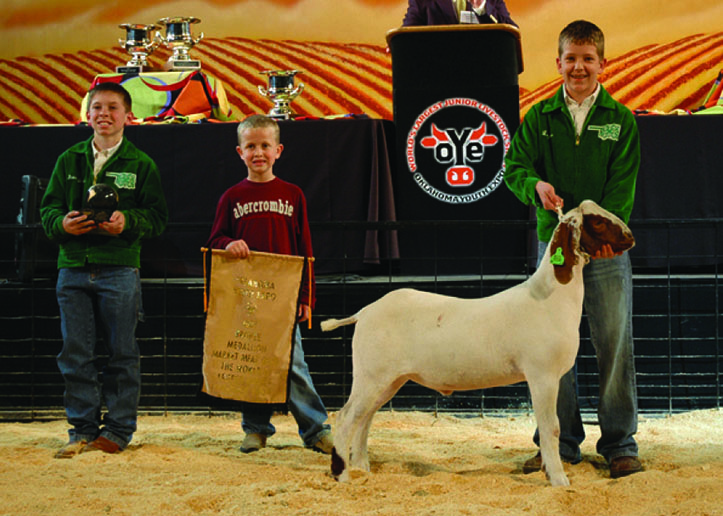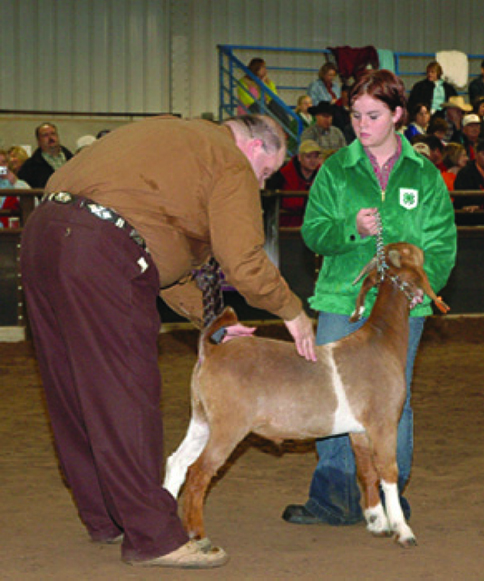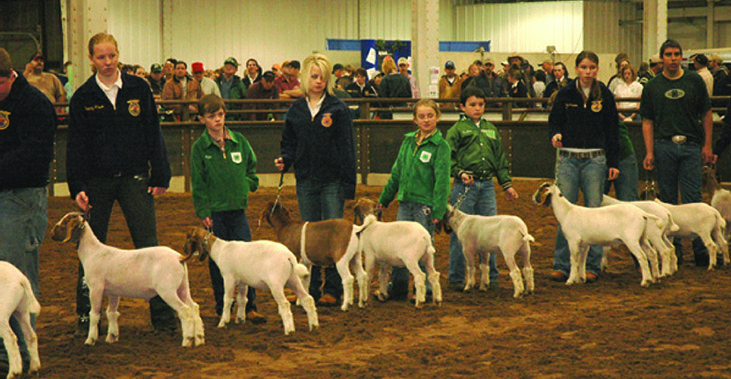Meat Goat Showmanship
A good showman is a person who has a sense or talent for an effective presentation of an animal. Showmanship is the one area of livestock showing which the exhibitor has the most control. In showmanship, you are judged on your abilities to control and present your goat to bring out its best characteristics. Advanced planning, practice and hard work are keys to becoming a good showman. Goat showmanship teaches many valuable lessons that can be used in day to day life. These lessons include responsibility, developing work ethic, determination to reach a goal, winning graciously and accepting setbacks with dignity. Winning takes practice at home and can become a reality by working with the goat on a daily basis.
Value of Working at Home
In the goat project, working at home is vital to becoming a successful showman. All good showmen begin training early and building a bond with their goat. Once a goat is weaned, immediately start spending time with your goat. Talking to or touching the animal while it eats will allow it to get used to you, build trust and allow it to become more comfortable with you. Remember, this process takes time and patience.
After the goat is familiar with you, the halter breaking process should begin. When halter breaking, be extremely careful and ALWAYS watch your animal when it is tied up. If goats are not watched closely, especially when they are first introduced to the halter, they could injure or harm themselves fatally.
Here are some helpful hints to assist the initial halter breaking process:
- Start halter-breaking early.
- You can make or buy collars, chains or inexpensive rope halters to use on your goat.
- Adjust the halter so the nose piece is half way between the eyes and mouth, or place the chain or collar around the goat’s neck.
- Goats should be caught, haltered, chained or collared and tied to a fence to start the halter breaking process. Don’t tie a goat with a dog-style choke chain, as the goat may seriously injure itself.
- As the animal becomes comfortable with the halter, you may begin to lead it. For the first few times leading the goat, try walking in a pen or enclosed area and leave more slack in the lead than you would normally use. Use light pressure on the chain. Let the animal become accustomed to the feel of the chain. The goat may jump, fall or twist when the chain is put on the first few times. Just remain patient, and calm the goat using a soothing tone of voice for reassurance. Using hay or feed to reward the animal may also be helpful.
- Once the goat is familiar with the chain, strengthen your grip when you walk the goat. Choose an area to walk that is not enclosed. Lead the goat with their head held high, so they walk naturally but still look appealing.
- When releasing the animal, never let them get away from you. Once an animal gets away, they think they can repeatedly do so. Stay calm, without jerking the chain.
- Practice makes perfect– Introduce the animal to all the procedures that will be followed when arriving at the show. Train your animal to set their feet properly. The goat’s feet should be at the corners of the body with the goat’s weight evening dispersed over its legs. Have another person handle the animal the way a judge would, so the animal becomes acquainted with this procedure. Allowing your animal to stand with their head held up high for about 20 minutes a day will teach them to keep their head high and be less stressful when they have to keep their head up in the show ring.
Leading for Exercise and Show
While exercising, the halter should be properly placed on the goat’s head with the lead rope on the goat’s left side. The halter strap that crosses over the muzzle or nose should be halfway between the eyes and the nose. Rope halters and show halters should be adjusted for proper fit. If the halter is too small it will get into the goat’s eyes. If the halter is too big, the nose band will be too close to the mouth. Your hand should be knuckle-side up with your smallest finger nearest the goat, three to six inches from the animal’s head.
During a show, leading a goat with a chain or collar is more acceptable than using a halter. Use of a halter is not recommended unless the exhibitor is smaller or younger in age. When not using a halter, use a chain or collar. The chain or collar should be held above the animal’s neck, with the chain or collar touching the goat’s throat (Figure 1). Your hand should be knuckle-side down with your smallest finger nearest your body.

Figure 1. Remaining in control of your goat during a show will help make your experience more successful. This training must take place before you get to the show.
When leading, you should be on the goat’s left side with the leading device in your right hand. When the goat is leading properly, its shoulders will be even with your leg and its head will be in front of your body. The goat should be led freely without tension on the chain.
The chain length should be long enough for control, but not too long to allow the animal to escape. Never wrap the chain around your hand or fingers as this could cause serious injury.
By the time you arrive at the show, the goat should already be trained to lead and stand correctly. Observe where you are going in the show ring and occasionally look back to see if your goat is walking in a straight path. Walk straight ahead at a moderate pace. During the lead, your goat’s head should be just high enough to present an impressive style, attractive side view and graceful walk (Figure 4). Let the goat walk out freely and naturally, not too fast and not to slow.
Be aware of the animal in front of you, and do not get too close at the walk or when setting up for a side view. Be observant for signals and instructions from the judge and ring official. When leading the goat in a circle, move in a clockwise direction, putting the goat between you and the judge. One of the key points in goat showmanship is never to obstruct the judge’s view.
Even though you have trained the goat to lead, sometimes it may not cooperate at a show. When the goat becomes stubborn and will not lead, keep your composure. Gently reach back and lift up on the goat’s tail. The goat will most likely react to this and start walking. Whether at a show or training at home, never whip a goat with a rope halter or grab the goat by the skin or hair. This can cause serious bruising to the goat.
Special Term
Setting up an animal: A showmanship term referring to the proper placement of a goat’s legs while being exhibited to a judge for evaluation. Your hand, boots or chain can help move the legs to the proper position under the animal so the animal is presented at its best appearance from the side, front or rear views.
Setting up Your Goat
When stopped with an animal in the show ring, you should stand on the opposite side of the animal from the judge (Figure 2). Keep two to three feet between you and the next animal so you do not crowd another exhibitor. Proper distancing allows for a better view and aids the judge in viewing and handling your goat. On a rear view, move around the goat’s front end and stand to the goat’s right side. When moving to a side view, the goats will be lined up directly behind one another, head to tail (Figure 2). It is important to keep a straight line.
If you are blocking the view of another animal and have space, move so the judge can see all the animals. If you are the one being covered up, it is your responsibility to get where the judge can see your animal. If you cannot get into the spot because it is too small, pull to the end of the line so you can be seen.

Figure 2. Side view. Use your hand closest to the goat to grasp the chain. As the judge comes, rotate so he or she may get a better view of your animal, keeping the animal between you and the judge at all times.
Quickly, yet smoothly, set up your goat with all four feet at the corners of the body and the goat’s weight evenly dispersed over its legs. Always set up the legs closest to the judge first. For example, if the judge is closest to your animal’s rear legs, set the rear legs of your animal first. When setting up your goat, you have three tools: your hands, boots and chain or collar.
To move a leg into place, grab the leg above the hock on the back leg or knee of the front leg with your hand and position it into the intended spot. Smaller exhibitors may not be able to reach over the goat to move its leg. In this case, applying pressure to the goat’s foot with your boot may be helpful. Also, if a back leg needs to be moved backwards, simply pulling the chain backwards may put the foot into place. By the time you reach a show, your goat should be trained to set itself up every time you stop it on the lead. This will ensure the judge has the optimum opportunity to view your animal.
While your goat is set up and the judge is appraising your animal, he or she may walk around your animal. It is important that you are aware the judge is coming. If the judge comes from the right side of your animal around the front of the animal’s head, you should be on the left side of the animal. When the judge comes even with you, take three steps to pivot around the front end to the other side of the goat. You should be standing on the right side of the goat with the judge on the left. This allows the judge to see more of your animal and lets the judge know you are aware of where he or she is standing. Move the opposite way if the judge comes from the opposite direction. When pivoting, switch hands also, keeping the hand closest to the goat on the chain.
Never place your hand on the goat’s back or the base of the neck. This will obstruct the judge’s view of the goat’s topline.
As the judge comes to handle your goat, stand with your attention on your goat (Figure 3). In general, do not touch your goat except for on the chain while the judge is handling your goat. Shows vary in their bracing rules, so be prepared to adjust for those variances.

Figure 3. Be alert as the judge comes to handle your goat. Keep the goat still and be careful not to touch the goat with your body, as bracing is not allowed.
Appearance
The animal should be clean, well-groomed and clipped in those areas as acceptable
or recognized for the breed or sex. The hair should be short clipped for market animals.
A good grooming job exemplifies pride of ownership by the exhibitor. The many hours
spent preparing your animal in advance of the show will be evident in the show ring.
You should be neat and clean just as the goat should be well-groomed. Remember, the
audience looks at you too. Fancy clothes are not necessary, but neatness and cleanliness
are important. Avoid faded blue jeans and T-shirts. Instead, go for a more professional
look with a tucked-in collared shirt. Check the show regulations concerning dress
code and always comply with the requirements such as wearing a specific shirt or jacket.
Practice good posture in showmanship because it shows pride in you and your animal. Stand with your back straight and never lean back. If you must lean, lean slightly forward as this expresses a positive interest of concern. Keep your feet relatively close together. Never let your feet become further than shoulder width apart.
When your animal is stopped, you may choose to scratch your animal with a long, calm stroke of your hand on their neck or belly. A fast stroke only shows that you’re nervous and can make your goat more nervous, defeating the purpose.
Always be aware of the judge’s location; however, do not concentrate on the judge so much that you forget about your animal and the animals around you. Your first obligation is to your goat, so keep checking to see that it is standing correctly and that it is in the proper position. Be ready to move if the judge signals, or answer any questions about your goat, such as age, breeding program, retail cuts, harvesting information, breed type or feeding program.
Show Time!
When you arrive at the show, check the show ring for low spots or dark areas. This will help you avoid these areas when setting up your goat, both improving the appearance of your animal and impressing the judge. If possible, every time you stop your animal, position the front legs on slightly higher ground and in a well lit area.
Be sure to know the show schedule and be ready when the class is called. A late arrival in the show ring may cause some confusion or distract the judge. It is wise to confirm that your goat is entered in the correct class. Animals entered in the wrong class cause confusion and slow down the show. If the show requires each exhibitor to have an entry card before entering the ring, make sure you have the card, and any other required record or identification. Observe the judging of a few classes prior to showing to familiarize yourself with ring procedures at each show and the judge’s preferred show style.

Figure 4. Every show ring is set up and run differently. Pay attention to the instructions given by both the ring official and judge.
When first entering the show ring, look for the ring official who is lining up your class. The ring official is there to help organize the class and minimize distractions for the judge. Be alert at all times, and carry out the instructions of the judge and ring officials closely.
One way to practice good sportsmanship is to assist others when you can. For example, if an animal stops in front of you, don’t wait for the ring assistant to come help. Instead, use your left hand to push the tail of the animal in front of you. Keep your right hand on your goat’s chain for control. This will keep the show moving properly and the judge will recognize you care about the success of others and not just yourself.
When the judge starts his reasons, the class is over, but your job is not. Continue to work hard and display good sportsmanship. Leave the ring in an orderly manner as instructed by the ring steward, and pick up your award.
Special Term
Good Sportsmanship: Occurs when opponents, show team members, officials and anyone else are treated with respect by livestock exhibitors. Good sportsmanship is practicing proper etiquette at all times within the show ring. The real winners are those who know how to persevere and to behave with dignity—whether they win or lose.
Have Fun and Do Your Best
Always be courteous to show officials, the judge, and other exhibitors. Good sportsmanship is an important part of showmanship. You will win graciously and accept setbacks with dignity. Show your appreciation for the sponsorship of the show by writing thank you notes. Be a good representative of your club, school, county, and family. Work hard, practice at home, always try to do better next time and profit from your mistakes as you gain experience. Above all have fun!
Rusty Gosz
Assistant Extension Specialist
